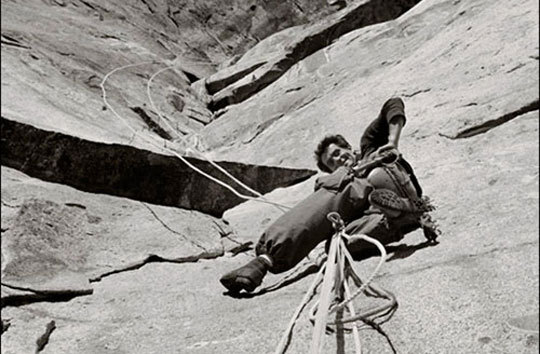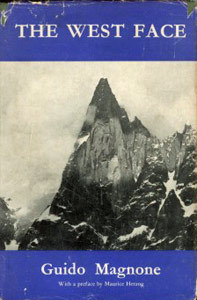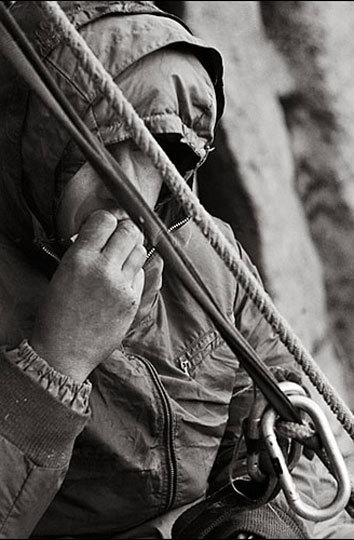
Yosemite Valley, 1964. El Capitan, which houses Dihedral Wall, is on the left; the Leaning Tower is just right of the three Cathedral Rocks in shadow. [Photo] Glen Denny
Many climbers have a favorite mountaineering book or essay. Athletes and guides, those whose lives are so deeply connected to climbing, often have literary obsessions–and everything from a story’s lyricism to its ethical stance has influenced how they approach the sharp end.
We at Alpinist picked a handful of climbers we found inspirational and asked them to share their literary influences. Also check out Vince Anderson’s take on The Satanic Bible in the January 2, 2008 Weekly Feature; Kelly Cordes and Masatoshi Kuriaki’s vision of High Alaska in the January 30, 2008 Weekly Feature; Simon Richardson’s chapter on Gervasutti’s Climbs in the February 6, 2008 Weekly Feature, Royal Robbins’s infatuation with High Conquest in the April 2, 2008 Weekly Feature; Damien Gildea’s multiple inspirations in the April 16, 2008 Weekly Feature and Marko Prezelj’s evolving philosophy in the April 23, 2008 Weekly Feature.
Glen’s inspiration, though originating an ocean away from Yosemite, is particularly meaningful to us at Alpinist now–we just released Alpinist 25, our Yosemite issue that profiles El Capitan (new subscribers save 33 percent off the newsstand rate, for a limited time).

West face of the Leaning Tower, 1965. [Photo] Glen Denny

Warren Harding on the first ascent of the west face of the Leaning Tower, 1961. [Photo] Glen Denny

Glen Denny on The West Face, by Guido Magnone
In the summer of 1961 we started up the west face of the Leaning Tower. It was slow going, and a Yosemite heat wave wiped us out, so we took a break and drove north to cool off on Mt. Robson, in the Canadian Rockies.
George Whitmore was an avid collector of mountaineering books, and on the way we stopped in at his favorite Seattle bookstore. There I discovered The West Face, by Guido Magnone, which described the 1952 first ascent of the west face of the Dru, in the French Alps. The photographs looked a lot like Yosemite, especially the famous 90-meter diedre, a smooth, overhanging open book capped by huge ceilings. This was all very inspiring, and I couldn’t wait to get back to Yosemite. In the fall, we finished the first ascent of the west face of the Tower.

Page 129 from Magnone’s The West Face. [Photo] Guido Magnone

Dihedral Wall, on the first ascent, El Capitan, 1962. [Photo] Glen Denny
That winter I was back in school, but I read The West Face more than any of my textbooks. I kept it propped open on my desk, pondering the photos and their eloquent captions. In the college library I found another climbing book, published in 1947, containing a striking photo of the Dru. The caption read: “Igneous rock surging up in enormous blocks of compact stone with scarcely a split in them. Of such is the west face of the Dru, on which no man has yet set foot.” After that, how could I concentrate on homework?
I worked hard at perfecting my big wall skills, and in the fall of 1962, we made the first ascent of the Dihedral Wall on El Capitan. During the long, cold bivouacs, quotes from Magnone’s book kept coming back to me: “Two nightmarish walls spun away into the sky, forming an immense open book.” Parts of the Dihedral looked like that, but they didn’t give me nightmares. I loved being there. I had discovered a new life, and The West Face helped me find it.

Bivouac on the Dihedral Wall, 1962. [Photo] Glen Denny
About Glen Denny
Glen Denny was born in Modesto, California, in 1939 and grew up in the nearby town of Livingston, where his father was a high school teacher. His first outdoor experiences came through fly-fishing trips into the Sierra with his father. When Glen moved to Yosemite in 1958 to learn to climb, the first ascent of El Capitan was under way. Inspired by this historic event, he was soon climbing the most challenging routes in Yosemite Valley, including some of the early ascents of El Capitan, with many of the big-wall pioneers of the late 1950s and early 1960s. He also has made first ascents in the Cordillera Huayhuash in Peru and the Hindu Kush in Afghanistan. Originally self-taught, Glen began photographing Yosemite climbs and climbers in the early Sixties before studying photography and filmmaking at San Francisco State University, where he earned a Masters of Fine Arts degree. His climbing films have won awards at several film festivals; his photography has appeared in a number of publications, culminating in his 2007 book, Yosemite in the Sixties, the source of the photographs shown in this feature. Yosemite in the Sixties recently won prizes at the Banff Mountain Book Festival and the National Outdoor Book Awards. Glen currently lives in San Francisco.